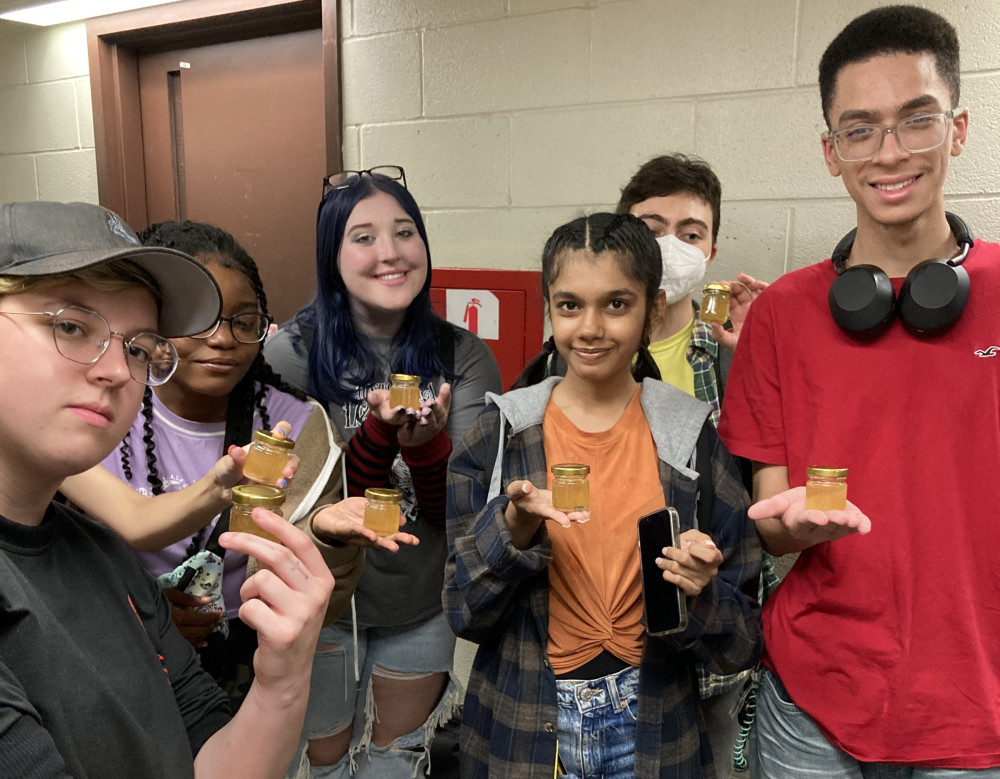The Buzz About Bees: Collecting Honey to Examine DNA
Hands-On Science for Non-Science Majors
With a backdrop of beautiful fall weather, Assistant Professor of Biology Stephen Harris brought students to the Natural Sciences building, where they extracted honey from freshly collected frames courtesy of our Purchase College honey bees.
It’s part of a new Liberal Studies course, The Buzz About Bees (LBS3032), taught by Dr. Harris and Professor of Sociology and Gender Studies Lisa Jean Moore, in which students learn about beekeeping, the honey bees’ importance to biodiversity, and the relationship between honey bees and humans.
Dr. Harris is using the collected honey to examine how honey bees living in urban or rural areas sample different flowers for honey production.
With Dr. Moore, the students investigate the social and cultural meaning of bees through sociology, anthropology, literature, and film. The class has explored how having a critical animal studies perspective changes the way we interpret our relationships with invertebrates.
Promoting Student Research
The honey extracted by LBS students will be used by senior biology students for their research projects. They’ll extract DNA from the plant pollen in the honey and identify which species the honey bees visited.
Students in The Buzz About Bees will also extract DNA from the honey later in the semester to confirm the presence of plant DNA, which helps us understand the impact humans have on biodiversity as we alter the landscape around us. The human infrastructure of New York City is very different from the rural landscapes of the Hudson Valley. Dr. Harris’s research investigates whether urban and rural honey bees are influenced by urbanization, measured by the diversity of plants the honey bees visit while collecting nectar along this rural to urban gradient.
“I have always promoted the idea of democratizing science and have worked around the world to bring molecular biology to students not usually exposed to these ideas,” says Harris. “That is why I was so excited to teach the biology of honey bees to non-science liberal studies majors, allowing them to get some of these hands-on experiences of beekeeping, DNA extractions, and molecular biology.”
One in 20K: The Non-Native Honey Bee
A non-native species to North America, honey bees have been intensely managed by humans for thousands of years. The western honey bee, the most common species used in the U.S., was native to Africa and Europe before spreading around the globe.
While important pollinators, the western honey bee is just one of about 20,000 species. Students in The Buzz about Bees course learn the importance of protecting all pollinating bees. Arguably, native non-solitary bees are more important for pollination and promoting biodiversity. They have specialized relationships with native flowers and plants allowing much more efficient pollination. In some ways, raising honey bees to save the bees is like raising chickens to save the birds.
The Role of eDNA and Protecting Organisms
Plant DNA extracted from honey is an example of environmental DNA (eDNA) that Dr. Harris frequently uses in his work. The eDNA allows for non-invasive study of biodiversity, avoiding direct sampling or harming organisms. Aquatic animal DNA from ponds and prey DNA from predator scat are also examples that help us better understand urban ecosystems.
Students enjoy the efforts of their hard work. Each receives their own jar of Purchase College Honey.